1997 CHEVROLET ASTRO clock setting
[x] Cancel search: clock settingPage 147 of 404

Downloaded from www.Manualslib.com manuals search engine Section 3 Comfort Controls and Audio Systems
In this section, you’ll find out how to operate the comfort control and audio systems offered with your vehicle. Be
sure to read about
the particular systems supplied with your vehicle.
3-2 3-2
3-3 3
-4
3 -5
3-5
3-6
3-6
3-6 3-8
3-9
3-9
3-9
3 -9 Comfort Controls
Heating/Air Conditioning System
Heating System
Rear Heating System (Option) Rear Air Conditioning System (Option)
Air Conditioning
Heating
Defrosting
Ventilation System
Rear Window Defogger (Option)
Audio Systems
Setting the Clock for Systems without
Automatic Tone Control
Setting the Clock for Systems
with
Automatic Tone Control
AM-FM Stereo 3-1
1
3-13
3-18
3-19
3-24
3-26
3-28
3-28
3-29
3-30
3-30
AM-FM Stereo with Cassette Tape
Player
(If Equipped)
AM-FM Stereo with Cassette Tape and
Automatic Tone Control
(If Equipped)
Rear Seat Audio
(If Equipped)
AM-FM Stereo
with Compact Disc Player and
Automatic Tone Control (If Equipped)
Playing a Compact Disc
in the Single Remote
Disc Player
(If Equipped)
Theft-Deterrent Feature Understanding Radio Reception
Tips About Your Audio System
Care
of Your Cassette Tape Player
Care
of Your Compact Discs
Fixed Mast Antenna
3-1
Page 148 of 404
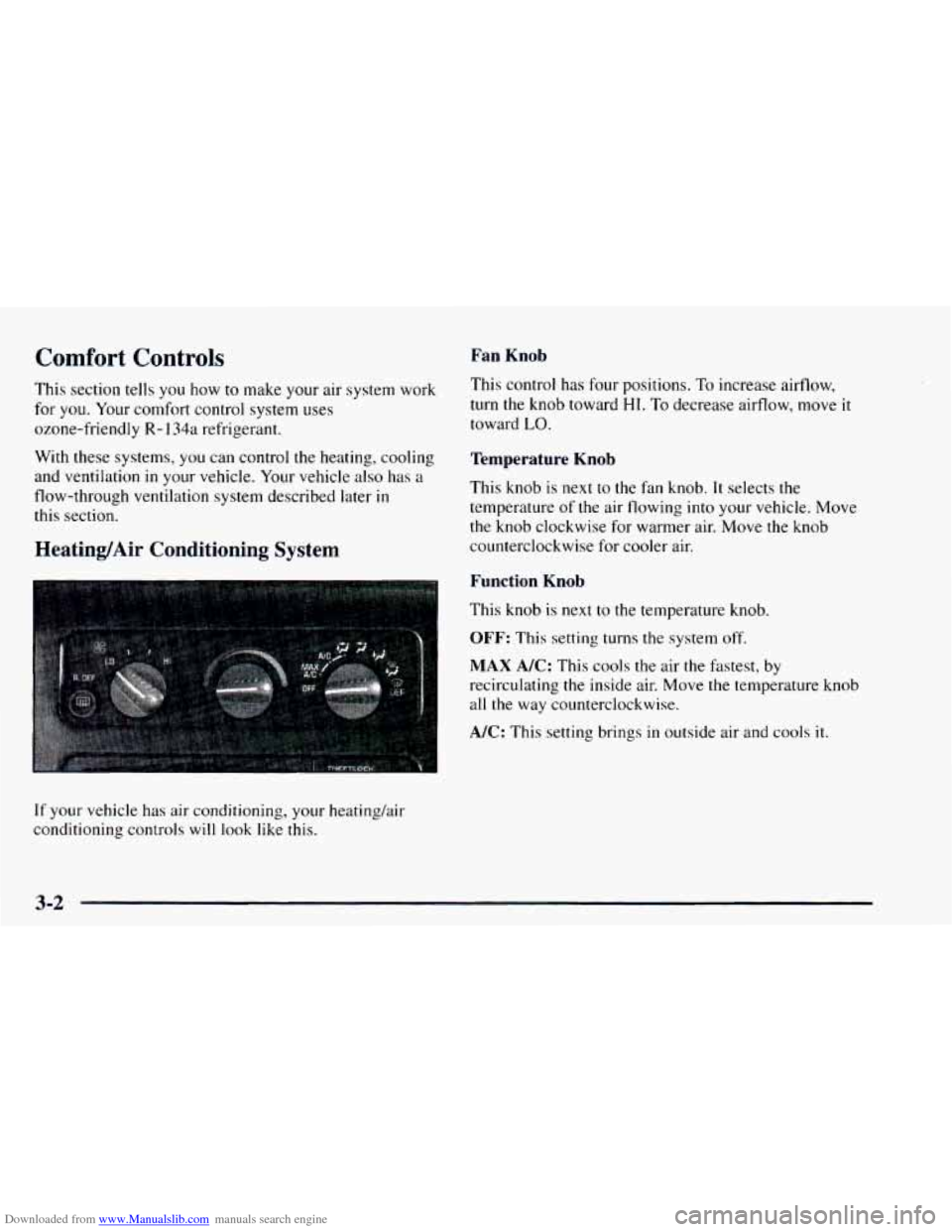
Downloaded from www.Manualslib.com manuals search engine Comfort Controls
This section tells you how to make your air system work
for you. Your comfort control system uses
ozone-friendly
R- 134a refrigerant.
With these systems, you can control the heating, cooling
and ventilation
in your vehicle. Your vehicle also has a
flow-through ventilation system described later
in
this section.
Heating/Air Conditioning System
If your vehicle has air conditioning, your heatinghir
conditioning controls will
look like this.
Fan Knob
This control has four positions. To increase airflow,
turn the knob toward
HI. To decrease airflow, move it
toward LO.
Temperature Knob
This knob is next to the fan knob. It selects the
temperature
of the air flowing into your vehicle. Move
the knob clockwise for warmer air. Move the knob
counterclockwise for cooler air.
Function Knob
This knob is next to the temperature knob.
OFF: This setting turns the system off.
MAX A/C: This cools the air the fastest, by
recirculating the inside air. Move the temperature knob
all the way counterclockwise.
A/C: This setting brings in outside air and cools it.
3-2
Page 149 of 404
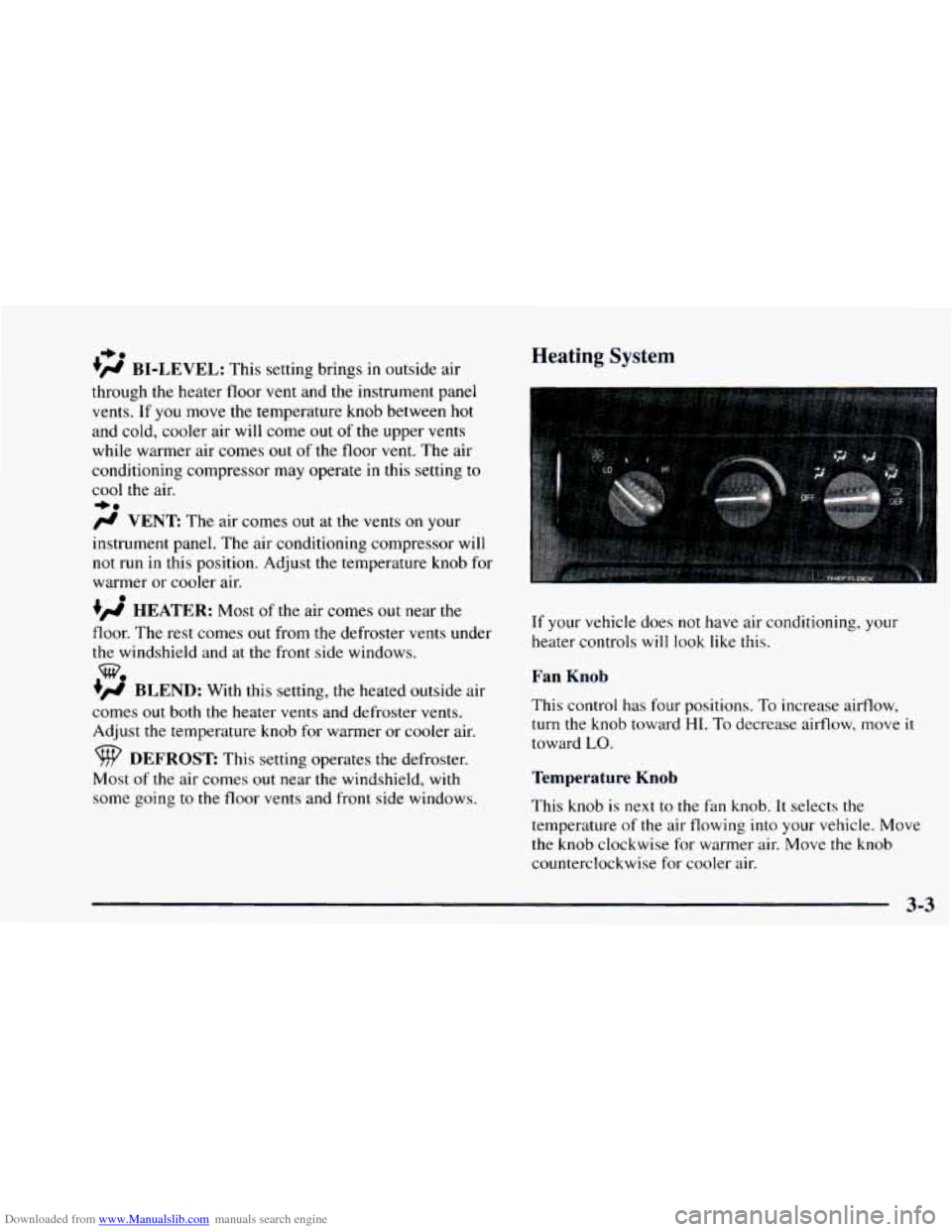
Downloaded from www.Manualslib.com manuals search engine +.
+# BI-LEVEL: This setting brings in outside air Heating System
through the heater floor vent and the instrument panel
vents. If
you move the temperature knob between hot
and cold, cooler air will come out of the upper vents
while warmer air comes out
of the floor vent. The air
conditioning compressor may operate in this setting
to
cool the air.
+e
/J VENT: The air comes out at the vents on your
instrument panel. The air conditioning compressor will
not run in this position. Adjust the temperature knob for
warmer or cooler air.
+’ HEATER: Most of the air comes out near the
floor. The rest comes
out from the defroster vents under
the windshield and at the front side windows.
we
+’ BLEND: With this setting, the heated outside air
comes out both
the heater vents and defroster vents.
Adjust the temperature knob for warmer or cooler air.
0
DEFROST This setting operates the defroster.
Most
of the air comes out near the windshield, with
some going to the floor vents and front side windows.
If your vehicle does not have air conditioning, your
heater controls will
look like this.
Fan Knob
This control has four positions. To increase airflow,
turn the knob toward
HI. To decrease airflow, move it
toward LO.
Temperature Knob
This knob is next to the fan knob. It selects the
temperature of the air flowing into your vehicle. Move
the knob clockwise for warmer air. Move the knob
counterclockwise
for cooler air.
3-3
Page 155 of 404

Downloaded from www.Manualslib.com manuals search engine Audio Systems
Your Delco@ audio system has been designed to operate
easily and give years
of listening pleasure. You will get
the most enjoyment out of it if you acquaint yourself
with
it first. Find out what your Delco system can do
and how
to operate all its controls, to be sure you’re
getting
the most out of the advanced engineering that
went into it.
AM-FM Stereo
Setting the Clock for Systems without
Automatic Tone Control
Press SET. Within five seconds, press and hold the
SEEK right arrow until the correct minute appears on
the display. Press and hold the
SEEK left arrow until the
correct hour appears on the display.
Setting the Clock for Systems with
Automatic
Tone Control
Press and hold HR until the correct hour appears on the
display. Press and hold MIN until the correct minute
appears on the display. To display the clock with the
ignition off, press RECALL or HR/MIN and
the time
will be displayed for a few seconds. There is an initial
two-second delay before the clock goes
into the
time-set mode.
Playing the Radio
VOLUME: This knob turns the system on and off and
controls the volume. To increase volume and turn
the
radio on, turn the knob clockwise. Turn it
counterclockwise
to decrease volume.
RECALL: Display the time with the ignition off by
pressing
the recall knob. When the radio is playing,
press this knob
to recall the station frequency.
3-9
Page 160 of 404

Downloaded from www.Manualslib.com manuals search engine SCV Your system has a feature called
Speed-Compensated-Volume (SCV). With
SCV, your
audio system adjusts automatically to make up for road
and wind noise as
you drive. Set the volume at the
desired level. Move the control ring behind the upper
knob clockwise to adjust
the SCV. Then, as you drive,
SCV automatically increases
the volume, as necessary,
to overcome noise at any particular speed. The volume
level should always sound the same
to you as you drive.
If you don’t want to use SCV, turn the control all the
way down. Each detent
on the control ring allows for
more volume compensation at a faster rate of speed.
Finding a Station
AM-FM:
Press this button to switch between AM, FM1
and FM2. The display will show your selection.
TUNE: Press this knob lightly so it extends. Turn it to
choose radio stations. Push the knob back into its stored
position when you’re not using
it.
SEEK: Press the right arrow to tune to the next higher
station and the left arrow to tune to the next lower station
and stay there. The sound will mute while seeking.
SCAN: Press and hold SEEK for two seconds until
SCAN appears on
the display. SCAN allows you to
listen to stations for a few seconds. The receiver will
continue
to scan and momentarily stop at each station
until you press the button again. The sound will mute
while scanning.
PUSHBUTTONS: The six numbered pushbuttons let
you return to your favorite stations.
You can set up to
18 stations (six AM, six FM 1 and six FM2). Just:
1.
2.
3.
4.
5.
6.
Turn the radio on.
Press AM-FM
to select the band.
Tune
in the desired station.
Press AUTO
TONE to select the setting you prefer.
Press and hold one
of the six pushbuttons. The sound
will mute. When it returns, release the button.
Whenever
you press that numbered button, the
station
you set will return and the tone you selected
will be automatically selected for that button.
Repeat the steps for each pushbutton.
3-14
Page 161 of 404
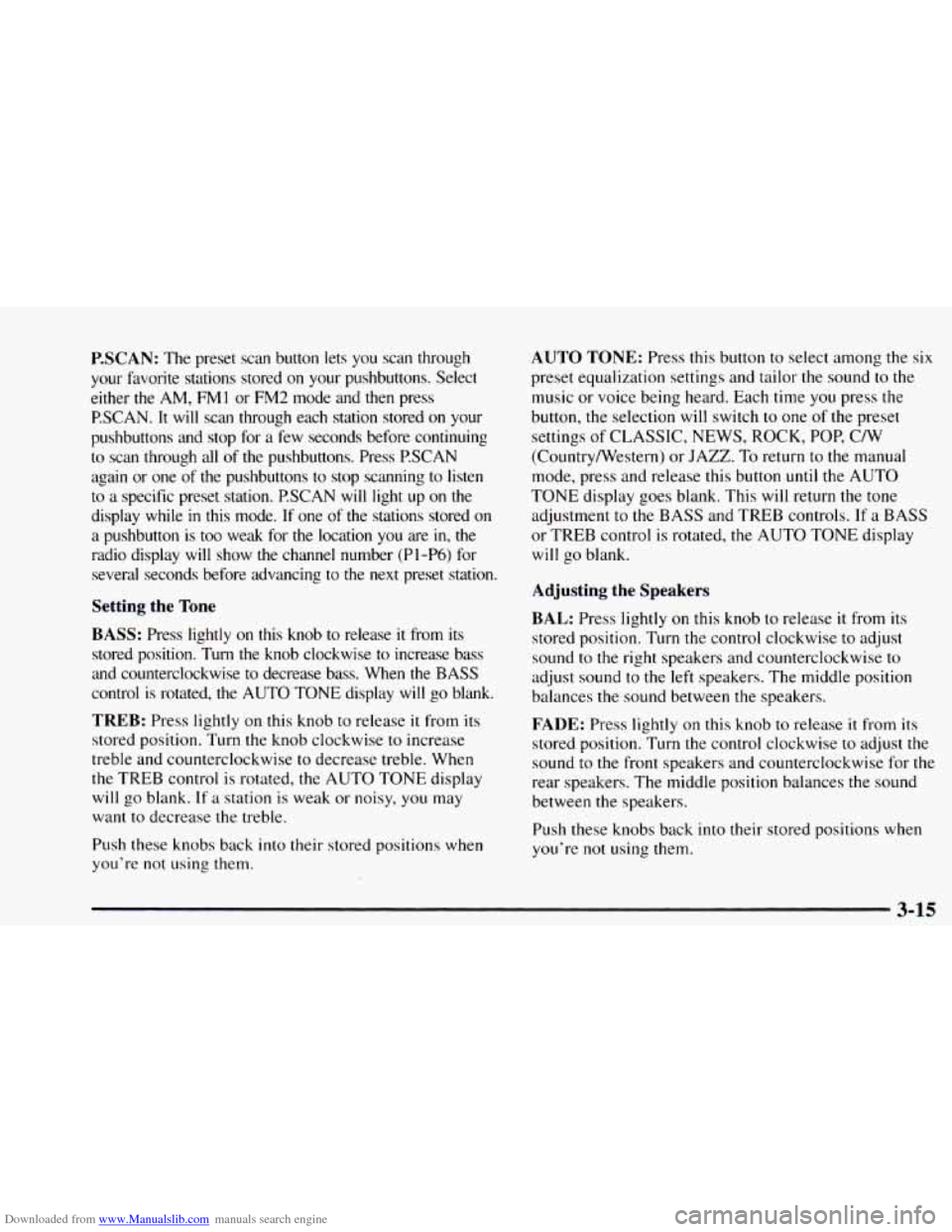
Downloaded from www.Manualslib.com manuals search engine P.SCAN: The preset scan button lets you scan through
your favorite stations stored
on your pushbuttons. Select
either the
AM, FM 1 or FM2 mode and then press
PSCAN.
It will scan through each station stored on your
pushbuttons and stop for
a few seconds before continuing
to scan through all of the pushbuttons. Press €?SCAN
again or one of the pushbuttons to stop scanning
to listen
to a specific preset station. P.SCAN will light up
on the
display while
in this mode. If one of the stations stored on
a pushbutton
is too weak for the location you are in, the
radio display will show the channel number (Pl-P6)
for
several seconds before advancing to the next preset station.
Setting the Tone
BASS:
Press lightly on this knob to release it from its
stored position. Turn
the knob clockwise to increase bass
and counterclockwise to decrease bass. When the BASS
control is rotated, the AUTO TONE display will go blank.
TREB: Press lightly on this knob to release it from its
stored position. Turn the knob clockwise to increase
treble and counterclockwise
to decrease treble. When
the TREB control is rotated,
the AUTO TONE display
will go blank. If a station is weak or noisy, you may
want
to decrease the treble.
Push
these knobs back into their stored positions when
you’re not using them.
AUTO TONE: Press this button to select among the six
preset equalization settings and tailor the sound to the
music or voice being heard. Each time
you press the
button, the selection will switch to one of the preset
settings
of CLASSIC, NEWS, ROCK, POP, C/W
(CountryNestern)
or JAZZ. To return to the manual
mode, press and release this button
until the AUTO
TONE display goes blank. This will return the tone
adjustment to the BASS and TREB controls.
If a BASS
or TREB control is rotated, the AUTO TONE display
will go blank.
Adjusting the Speakers
BAL: Press lightly on this knob to release it from its
stored position. Turn
the control clockwise to adjust
sound to the right speakers and counterclockwise to
adjust sound
to the left speakers. The middle position
balances the sound between the speakers.
FADE: Press lightly on this knob to release it from its
stored position. Turn the control clockwise to adjust the
sound to the front speakers and counterclockwise for the
rear speakers. The middle position balances
the sound
between the speakers.
Push these knobs back
into their stored positions when
you’re
not using them.
3-15
Page 166 of 404
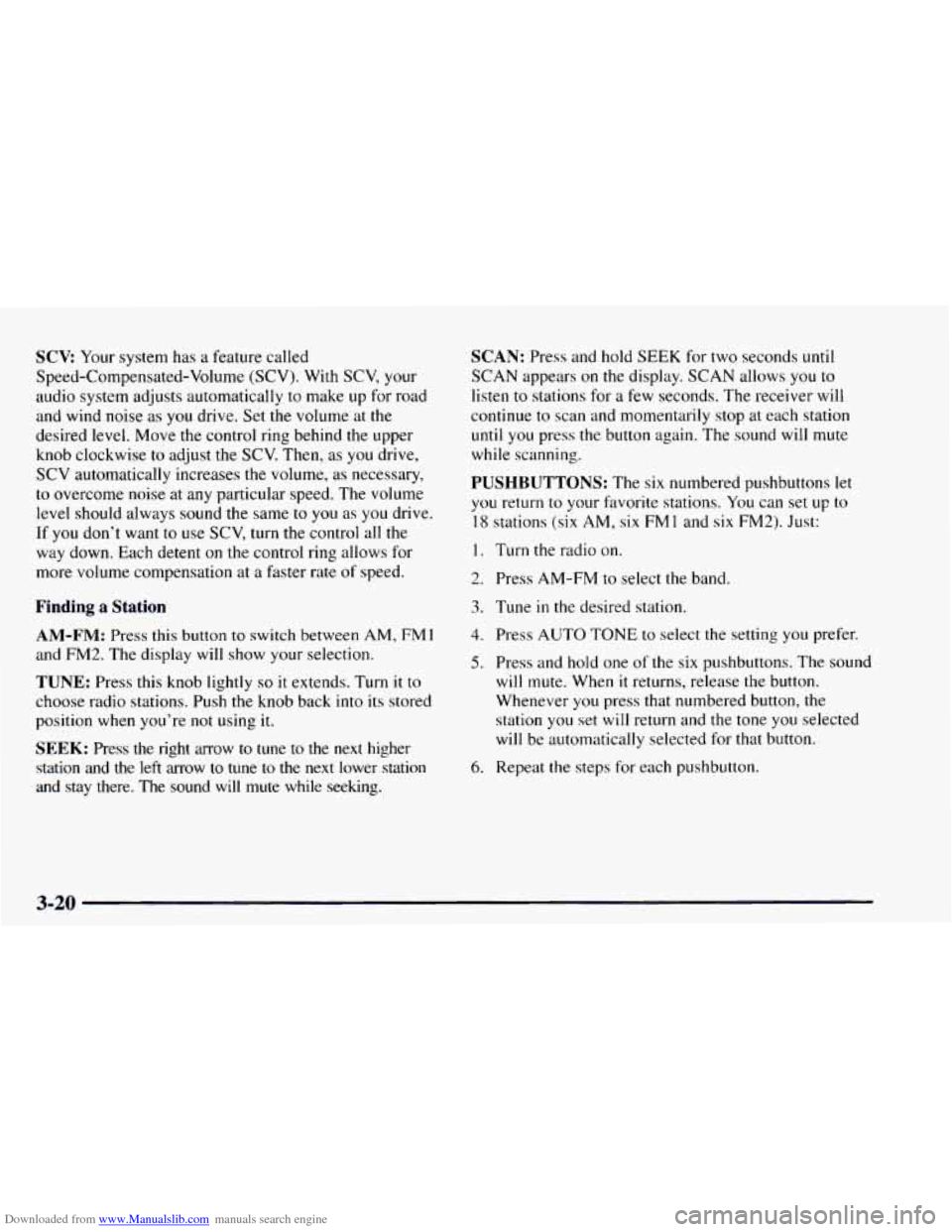
Downloaded from www.Manualslib.com manuals search engine SCV Your system has a feature called
Speed-Compensated-Volume (SCV). With SCV, your
audio system adjusts automatically to make
up for road
and wind noise as
you drive. Set the volume at the
desired level. Move the control ring behind the upper
knob clockwise
to adjust the SCV. Then, as you drive,
SCV automatically increases the volume, as necessary,
to overcome noise at any particular speed. The volume
level should always sound the same
to you as you drive.
If you don’t want to use SCV, turn the control all the
way down. Each detent
on the control ring allows for
more volume compensation at a faster rate
of speed.
Finding a Station
AM-FM: Press this button to switch between AM, FM 1
and FM2. The display will show your selection.
TUNE: Press this knob lightly so it extends. Turn it to
choose radio stations. Push
the knob back into its stored
position when you’re not using it.
SEEK: Press the right mow to tune to the next higher
station and the left arrow to tune
to the next lower station
and stay there. The sound will mute while seeking.
SCAN: Press and hold SEEK for two seconds until
SCAN appears on the display. SCAN allows you to
listen to stations for
a few seconds. The receiver will
continue to scan and momentarily stop at each station
until you press the button again. The sound will mute
while scanning.
PUSHBUTTONS: The six numbered pushbuttons let
you return to your favorite stations. You can set up
to
18 stations (six AM, six FM 1 and six FM2). Just:
1. Turn the radio on.
2. Press AM-FM to select the band.
3. Tune in the desired station.
4. Press AUTO TONE to select the setting you prefer.
5. Press and hold one of the six pushbuttons. The sound
will mute. When
it returns, release the button.
Whenever you press that numbered button, the
station
you set will return and the tone you selected
will be automatically selected for that button.
6. Repeat the steps for each pushbutton.
3-20
Page 167 of 404
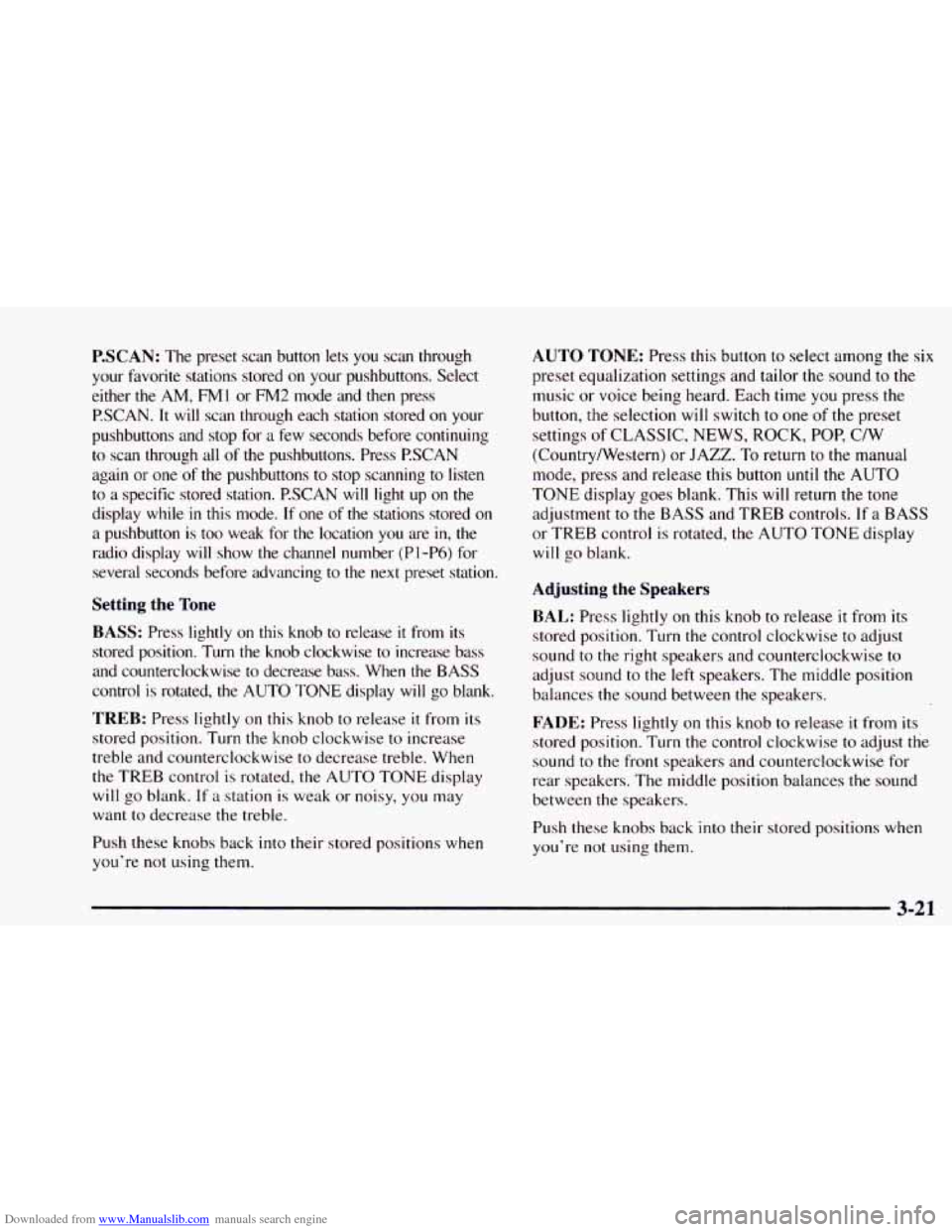
Downloaded from www.Manualslib.com manuals search engine P.SCAN: The preset scan button lets you scan through
your favorite stations stored on your pushbuttons. Select
either the AM, FMl
or FM2 mode and then press
P.SCAN.
It will scan through each station stored on your
pushbuttons and stop for a few seconds before continuing
to scan through all of the pushbuttons. Press PSCAN
again or one of the pushbuttons
to stop scanning to listen
to a specific stored station. PSCAN
will light up on the
display while
in this mode. If one of the stations stored on
a pushbutton is too weak for the location you are in, the
radio display will show the channel number (Pl-P6) for
several seconds before advancing
to the next preset station.
Setting the Tone
BASS:
Press lightly on this knob to release it from its
stored position. Turn the knob clockwise to increase bass
and counterclockwise to decrease bass. When the BASS
control is rotated, the AUTO TONE display will
go blank.
TREB: Press lightly on this knob to release it from its
stored position. Turn the knob clockwise to increase
treble and counterclockwise
to decrease treble. When
the TREB control is rotated, the AUTO TONE display
will go blank.
If a station is weak or noisy, you may
want
to decrease the treble.
Push these knobs back into their stored positions when
you’re
not using them.
AUTO TONE: Press this button to select among the six
preset equalization settings and tailor the sound
to the
music or voice being heard. Each time you press the
button, the selection will switch
to one of the preset
settings of CLASSIC, NEWS, ROCK, POP,
CN
(CountryNestern) or JAZZ. To return to the manual
mode, press and release
this button until the AUTO
TONE display goes blank. This will return the tone
adjustment
to the BASS and TREB controls. If a BASS
or TREB control is rotated,
the AUTO TONE display
will go blank.
Adjusting the Speakers
BAL: Press lightly on this knob to release it from its
stored position. Turn the control clockwise to adjust
sound to the right speakers and counterclockwise
to
adjust sound to the left speakers. The middle position
balances the sound between
the speakers.
FADE: Press lightly on this knob to release it from its
stored position. Turn the control clockwise to adjust the
sound
to the front speakers and counterclockwise for
rear speakers. The middle position balances
the sound
between the speakers.
Push these knobs back
into their stored positions when
you’re not using them.
3-21